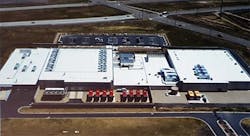There’s a major new player in the cloud data center arms race, as database giant Oracle Corp. is seeking to add capacity to support its push into cloud services, according to a new report.
As Oracle shifts its business model toward the cloud, it is seeking to lease large amounts of wholesale data center space, according to North American Data Centers, which tracks data center inventory across the country. Oracle began adding leased server space last year, when it leased 5 megawatts of capacity with Digital Realty in suburban Chicago, according to the report.
Now Oracle is seeking to expand its data center footprint in northern Virginia, currently the nation’s hottest market for cloud real estate. Real estate sources in northern Virginia say Oracle may seek to deploy as much as 25 megawatts of data center capacity in the region, according to Jim Kerrigan of North American Data Centers.
Oracle isn’t the only cloud player seeking large amounts of data center real estate. Microsoft is continuing its aggressive cloud expansion to support its Azure cloud services, and hopes to line up 30 megawatts of additional space in northern Virginia as well as additional capacity in the Chicago market, Kerrigan says. That’s on top of the 47 megawatts of wholesale space that Microsoft leased in the first quarter of 2016.
Neither Oracle nor Microsoft have finalized plans in northern Virginia or made public announcements of expansions in the region. But their data center shopping spree illustrates how the growth of cloud computing is turbo-charging the market for wholesale data center space.
Oracle Beefs Up Its Cloud
Oracle CEO Larry Ellison was once known for his disdain for cloudy jargon. But in recent years Oracle has begun shifting to a cloud delivery model.
Oracle now has offerings in all three sectors of the cloud market: software-as-a-service (SaaS), platform-as-a-service (PaaS) and infrastructure-as-a-service (IaaS). Oracle’s SaaS services include enterprise resource planning (ERP) and human resources applications, while its PaaS offerings are led by its Oracle Database Cloud Service, which allows customers to run databases in Oracle’s server farms rather than their on-premise facilities.
In 2015 Oracle entered the IaaS market, which has been dominated by Amazon Web Services. Oracle Cloud offers elastic compute, storage and networking services on a subscription basis.
These IaaS services may be attractive to companies that are running applications on Oracle’s SaaS and PaaS platforms and want to reduce latency in moving data between their public and private clouds (eliminating the round trip to a private cloud at Amazon, for example).
“There’s a huge amount of demand or our infrastructure-as-a-service from our existing SaaS customers and our new SaaS customers, and even bigger amount of demand for infrastructure-as-a-service from our database customers,” Ellison said in the company’s earnings call last month.
“We’re growing fast in SaaS. We’re growing fast in PaaS,” Ellison added. “Now we need to grow fast in infrastructure-as-a-service. We’ve made the investments, we have the right technology with our second-generation data centers, and we’re very excited about the potential.”
Competing with Amazon requires some infrastructure, as demonstrated in the major data center expansion announcements this year from Google and Microsoft. So it’s not surprising that Oracle would also need to add capacity to compete in this market.
Oracle runs its online services out of data centers in Austin, Utah and Scotland. It also houses servers with some third-party data center providers.
A cut-away view of the data center design and cooling airflow for the Oracle Utah Compute Facility . (Image: Oracle)
The evolution of the Oracle Utah Compute Facility (UCF) in South Jordan, Utah illustrates the ongoing changes in technology and best practices, and Oracle’s emphasis on continuous refinement of data center design to strike a balance between sustainability, cost and operational efficiency. The Oracle data center team described the company’s data center evolution last fall at the 7×24 Exchange conference in San Antonio.
But the buildout of the Utah facility occurred over two years. By shifting to wholesale space, Oracle would be able to fill data halls with servers on a shorter timeline. In recent projects, wholesale providers have demonstrated the ability to deploy new capacity from the ground up in as little as six months.
The newest data halls in the Oracle Utah facility operate with a PUE of 1.18, a significant efficiency improvement over earlier designs. The facility uses indirect evaporative cooling and flywheel UPS systems.
The design features a ductless cooling system using multiple “decks” housing plenums to separate and transport hot and cold air. Supply air is dropped into the data hall, and from there is distributed to provide cooling for electrical rooms and telecom space. Racks are housed in a containment system, with a chimney system venting exhaust air from the hot aisle into the upper return plenum.
About the Author



